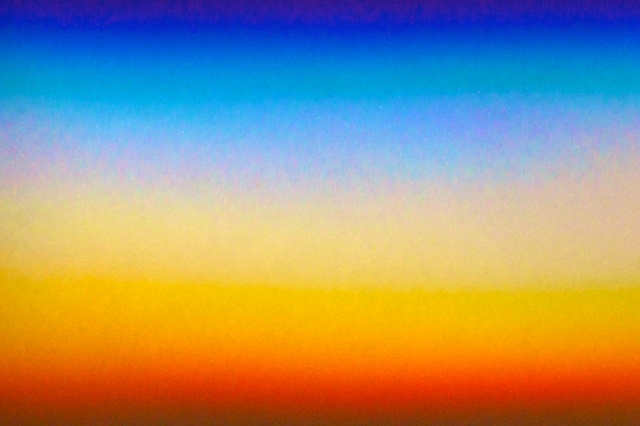We play around with “rainbows” for our One Picture a Day today. This spectrum was cast on the living room wall by sunlight coming through the beveled edges of decorative glass in our front door. These delightful sprites appear on sunny afternoons in our living room. On the wall and for the original image, the center area was a wide stripe of light, and the color sections were narrower. I threw it into Aperture’s adjustment tab to see what we could do.
My goal was to pull out as much color as I could. What made the biggest difference was to push saturation and vibrancy to the maximum setting. Those two settings pulled a lot of color out of the “white” section. At the same time, this widened the color bands so that more of each hue was seen. I tweaked exposure and contrast up slightly, and used the “Levels” tool to stretch the tonal range.
An artifact I was trying to avoid was the banding of colors, where gradual transitions are lost. I believe part of is a limitation of the display technology of the LCD screen on my computer, so it is difficult to get rid of all of it. On a true film photograph or a high-quality display perhaps that would be further reduced. I have no way of knowing.
It also picked up some blotchy character. I taped a piece of paper to the wall so that I would not have to fight wall texture. Paper is not really all that smooth if you look closely. Combined that with with pushing the colors so hard with the adjustments we lost smoothness. I have also noticed that images with areas of uniform color tend to emphasize the grain of higher ISO (this was taken at 1600 ISO). Of course, I’m still learning my way around post-processing. Someone with more experience would have a better idea of overcoming these things.
This photograph was taken with a Nikon D90, and a Nikon 18-300mm VR Telephoto zoom. I used the zoom because that’s what happened to be on the camera. The final image is cropped to eliminate extraneous elements that using a telephoto introduced. ISO 1600, f/7.1, 1/3200. The original image was unintentionally underexposed, but I chose it because it started with more color than my “properly exposed” shots; less of the middle was washed out in white.




